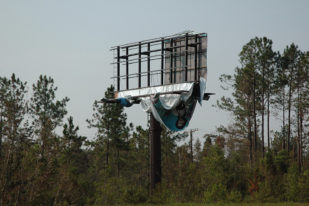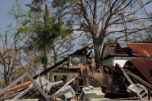Confronting Change
Helen White
Each year scientists measure shifts in the make-up of our global atmosphere, Arctic sea-ice coverage, and the loss and discovery of biological species. These environmental variations, in part a result of human activity, remain largely imperceptible in our daily lives. This was not the case with the 2010 Deepwater Horizon incident, which killed eleven people and released 4.9 million barrels of oil into the Gulf of Mexico. This catastrophic event was a painful reminder of our exploitation of the natural world, and the devastating consequences that inevitably result from our negligence.
In the aftermath of the Deepwater Horizon oil spill, underwater images of the exploded wellhead received round-the-clock media coverage. Thick slicks of oil coated the sea surface, beaches and wildlife. Those who relied on the Gulf for their livelihoods felt the immediate effects of the disaster. Others looked on helplessly as solutions to prevent oil gushing from the seafloor failed to materialize until almost three months after the initial explosion. During this time, the waters were closed to fishing and an offshore drilling moratorium was imposed.
Today the waters of the Gulf of Mexico are open to commercial activities, and the Gulf coast is largely back in business. Remnants of oil and injury from the spill, however, linger in the region and the longer-term effects are still being determined. The overall impact of the Deepwater Horizon oil spill on the Gulf coast environment remains inescapable; the environmental and human costs, undeniable. In September 2014, U.S. District Judge Carl Barbier ruled that British Petroleum (BP) was guilty of gross negligence and willful misconduct.
While not all threats to the environment are as obvious as an oil spill, those less evident (like human-induced climate change) may prove even more calamitous. Christopher Reddy, a scientist at Woods Hole Oceanographic Institution, contrasted the public’s widespread awareness of the Deepwater Horizon oil spill with our inability to comprehend the threat of carbon dioxide and climate change. Reddy suggests, “Perhaps we ignore carbon dioxide because it’s hard for us to think long-term and connect the dots. The consequences of oil spills are immediate; the causes and effects are obvious. Not so with carbon dioxide; its consequences are incremental, insidious, and irreversible for centuries to millennia.” Perhaps we can only respond to time spans we experience, changes we can witness in the moment of transformation. Reddy ponders, “What if carbon dioxide were as black as oil?”1
To suggest that we are merely oblivious to variations in our environment would be an oversimplification, but it does seem difficult for us to grasp long-term environmental change. Scientist James Hansen and colleagues write, “The greatest barrier to public recognition of human-made climate change is probably the natural variability of local climate. How can a person discern long-term climate change, given the notorious variability of local weather and climate from day to day and year to year?”2 With this in mind, it is imperative that we allow the experts to expand our sightlines. The Intergovernmental Panel on Climate Change (IPCC), whose job it is to “assess the scientific, technical and socio-economic information relevant for the understanding of the risk of human-induced climate change,”3 serves as a critical ally in expanding public awareness of environmental issues.
The 2014 IPCC Synthesis report recommends that fossil fuels be phased out by 2100. Sanyay Vashist, a fellow for the Climate Action Network, summarizes, “Even if you tweak the scientific findings, it doesn’t change that reality and the reality is we are facing a bleak future in absence of any ambition on mitigation.”4
It is precisely this lack of ambition that is so troubling. It is a common yet frequently ignored point that if we refuse to respond to the slow pace of climate change happening today, we will be left to deal with abrupt and irreversible changes that will occur in the not-too-distant future. But if the invisibility of climate change allows us to ignore it, then how can we motivate ourselves to take preventive measures before the effects manifest and accelerate? It is certain that we have no time to waste. If we fail to take action now, we will soon be obligated to confront grim environmental changes, likely in the form of new devastating losses.
Why do disasters force us to care? They insist that we confront our relationship to a world in constant flux. In Sea Change, Zoe Strauss offers images of people and places in the wake of disasters. The viewer is placed amidst the aftermath of Hurricanes Katrina and Sandy, and the Deepwater Horizon oil spill with people for whom a contingency plan was not implemented quickly enough. Strauss’s images allow us to contemplate both the devastation that these disasters unleashed and the resilience of the communities left in their wake. In Sea Change, Strauss invites us to consider the communities and environments forever altered by catastrophe, leaving us to imagine whether we as viewers—and as a society—can slow, or even turn, the tide.
- Reddy, C.M. What if carbon dioxide were as black as oil? (Opinion), CNN website, posted May 28th 2010. ↑
- Hansen, J., Sato, M., Ruedy, R. The New Climate Dice: Public Perception of Climate Change (Science Briefs) NASA website posted August 2012. ↑
- Emissions Scenarios, IPCC 2000, Nebojsa Nakicenovic and Rob Swart (Eds.) Cambridge University Press, UK. pp 570. ↑
- McGrath, M. IPCC preparing ‘most important’ document on climate change (News) BBC website, posted October 30th 2014. ↑




